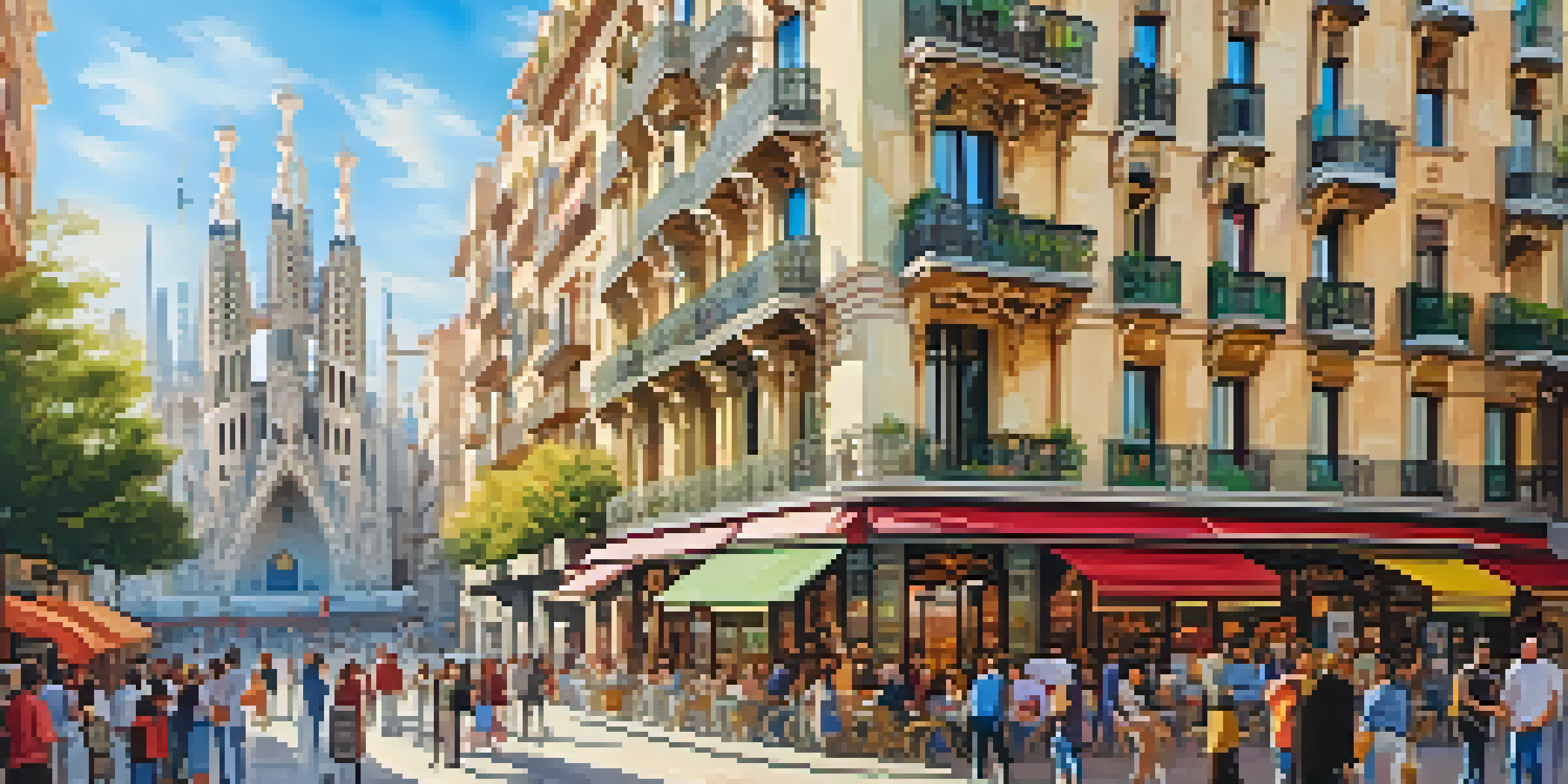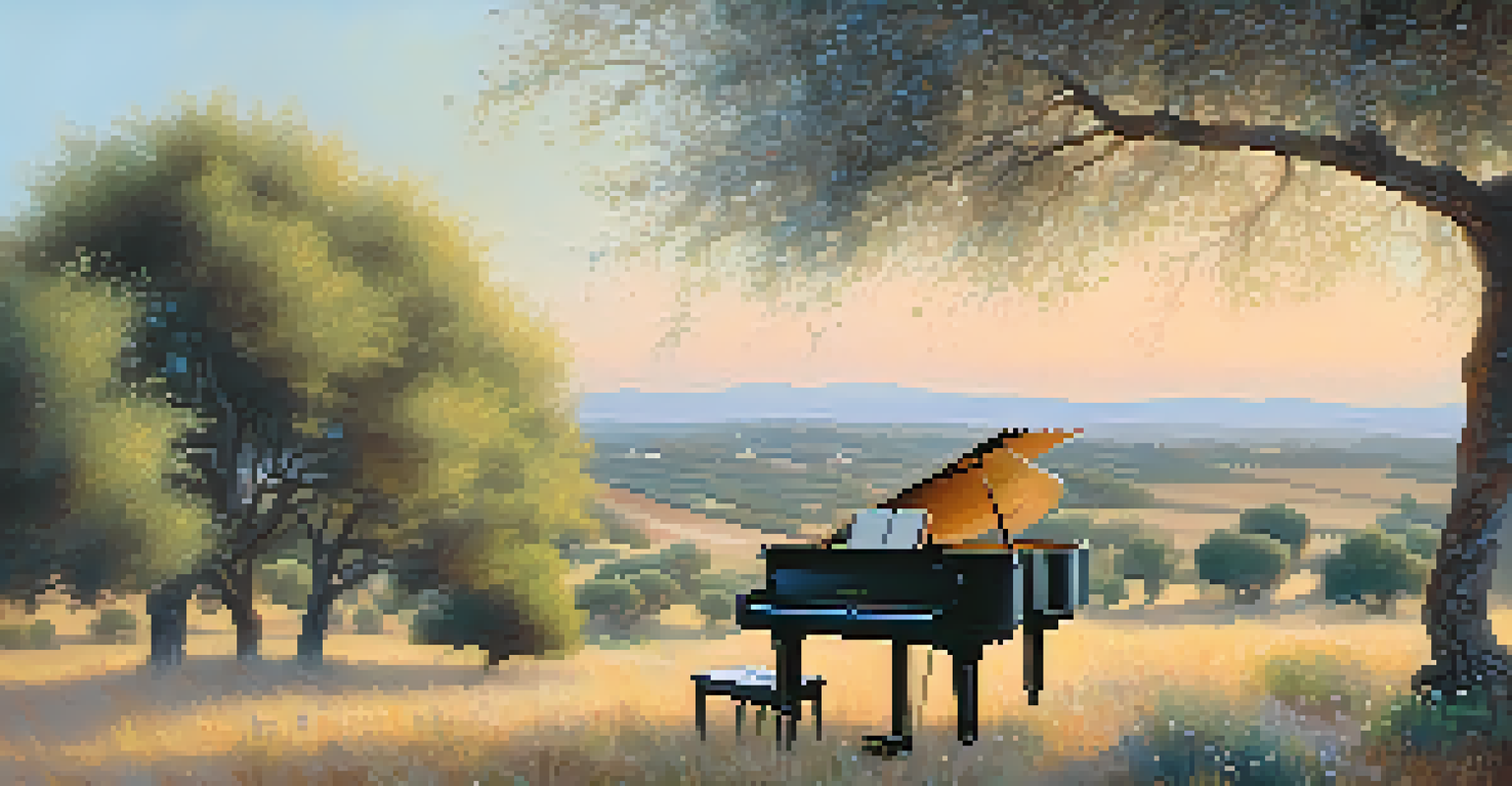Catalonia's Modernist Movement and Its Musical Heritage

Understanding Catalonia's Modernist Movement
Catalonia's Modernist movement, known as 'Modernisme,' blossomed in the late 19th and early 20th centuries. This artistic revolution was marked by a surge of creativity, reflecting the region's unique identity and cultural heritage. Architects, painters, and musicians collaborated, creating a vibrant environment that celebrated innovation and tradition. The movement not only transformed the visual landscape of cities like Barcelona but also influenced various musical styles that emerged during this period.
Art is the most beautiful of all lies; it is the truth that has been revealed through the imagination.
At the heart of Modernisme was a desire to break away from the constraints of previous artistic styles. Artists sought inspiration from nature, folklore, and the rich history of Catalonia, leading to a distinctive aesthetic that embraced ornamental designs and organic forms. This approach resonated deeply within the musical community, inspiring composers to explore new sounds and themes that echoed the same principles.
The legacy of Catalonia's Modernist movement is evident today, as it continues to inspire artists and musicians alike. Whether through the intricate architecture of Antoni Gaudí or the emotive melodies of contemporary Catalan composers, the influence of this era remains palpable. It serves as a reminder of the power of creativity in shaping cultural identity and the importance of artistic expression.
Key Figures in Catalonia's Modernist Music Scene
Several composers and musicians played pivotal roles in defining Catalonia's Modernist music scene. One of the most notable figures is Isaac Albéniz, whose compositions beautifully blended traditional Spanish melodies with innovative harmonies. Albéniz's works, such as 'Iberia,' showcase the rich diversity of Catalan culture while embracing modern techniques, making him a cornerstone of the movement.

Another significant figure is Manuel de Falla, who seamlessly integrated folk elements into his compositions. His ability to draw from the cultural wellspring of Catalonia and Andalusia allowed him to create works that resonated with both local and international audiences. Falla's music, rich with emotion and rhythm, exemplifies the spirit of Modernisme, celebrating the region's heritage while pushing artistic boundaries.
Catalonia's Modernisme: A Cultural Revolution
Catalonia's Modernist movement, known as 'Modernisme,' transformed the region's artistic landscape by blending innovation with cultural heritage.
These composers, along with others like Enric Granados and Xavier Montsalvatge, contributed to a flourishing musical landscape that paralleled the visual arts. Their innovative approaches not only enriched Catalonia's cultural tapestry but also played a crucial role in establishing a unique identity for Spanish classical music on the global stage.
Influence of Folklore on Modernist Compositions
Folklore served as a vital source of inspiration for many Modernist composers in Catalonia. By incorporating traditional melodies and rhythms into their works, these musicians created a bridge between past and present. This practice not only celebrated local culture but also infused their compositions with a sense of authenticity and emotional depth.
Music is the shorthand of emotion.
For example, composers often drew upon the rich tapestry of Catalan folk songs, weaving them into their original pieces. This blend of folk elements with contemporary styles allowed artists to explore themes of identity and belonging. As a result, the music resonated deeply with audiences, evoking a sense of pride in their cultural heritage.
The use of folk motifs also highlighted the importance of community and tradition within the Modernist movement. By embracing these elements, composers fostered a sense of continuity, reminding listeners of the enduring legacy of their cultural roots. This connection to folklore remains a defining characteristic of Catalonia's musical heritage today.
The Role of the Catalan Language in Modernist Music
The Catalan language played a crucial role in shaping the identity of the Modernist music movement. Composers began to incorporate Catalan lyrics into their works, which not only showcased their cultural pride but also made their music accessible to local audiences. This linguistic choice allowed artists to express themes and emotions that resonated with the Catalan people, fostering a deeper connection between the music and its listeners.
In many cases, the use of the Catalan language enriched the emotional landscape of musical compositions. Poets and lyricists collaborated with composers, creating works that reflected the region's unique stories and folklore. This collaboration resulted in a fusion of literary and musical artistry, giving rise to a distinctive sound that celebrated Catalonia's identity.
Folklore's Vital Role in Music
Modernist composers drew heavily from Catalan folklore, creating music that resonated with themes of identity and community.
Furthermore, the prominence of the Catalan language in Modernist music played a significant role in the broader cultural revival of the region. As artists embraced their linguistic heritage, it sparked a renewed interest in Catalan literature, theater, and visual arts. This cultural renaissance not only strengthened the identity of Catalonia but also contributed to the global appreciation of its rich artistic heritage.
Modernisme's Impact on Contemporary Catalan Music
The influence of Catalonia's Modernist movement continues to resonate in contemporary music. Many modern composers draw inspiration from the innovative spirit of their predecessors, infusing their works with a blend of traditional and modern elements. This ongoing dialogue between past and present allows for the evolution of Catalan music while honoring its roots.
For instance, contemporary artists often revisit folk themes and incorporate them into their compositions, reflecting the enduring legacy of the Modernist movement. This revival of interest in traditional music not only keeps the cultural heritage alive but also fosters a sense of unity among generations of musicians. It creates an exciting landscape where historical influences meet modern creativity.
Moreover, the global reach of Catalan music has expanded, thanks in part to the groundwork laid by Modernist composers. Festivals, collaborations, and international performances showcase the richness of Catalonia's musical heritage, allowing it to be appreciated by audiences worldwide. This growing recognition highlights the timelessness of the Modernist spirit, as it continues to inspire artists across diverse genres.
Celebrating Catalonia's Musical Heritage Through Festivals
Catalonia is home to a vibrant array of festivals that celebrate its rich musical heritage, many of which have roots in the Modernist movement. Events like the Festival Internacional de Música de Cadaqués and the Festival de Música de Barcelona attract both local and international talent, showcasing the region's artistic diversity. These festivals provide a platform for musicians to honor the traditions of the past while experimenting with new sounds.
During these events, audiences can experience a delightful mix of contemporary and traditional performances. By featuring works from Modernist composers alongside modern interpretations, festivals create a dynamic atmosphere that engages listeners and fosters a greater appreciation for Catalonia's cultural legacy. This celebration of music not only entertains but also educates attendees about the historical significance of the region's artistic contributions.
Future of Catalonia's Musical Legacy
Emerging artists continue to reinterpret Catalonia's Modernist musical heritage, ensuring its influence endures and evolves.
Moreover, these festivals often emphasize community involvement, inviting local artists and schools to participate. This inclusive approach helps to cultivate a new generation of musicians who are inspired by their heritage. By connecting the past with the present, these celebrations ensure that the spirit of Catalonia's Modernist movement continues to thrive for years to come.
The Future of Catalonia's Modernist Musical Heritage
As we look to the future, the legacy of Catalonia's Modernist musical heritage remains vital to its cultural landscape. Emerging artists are increasingly drawing from this rich history, seeking to reinterpret traditional themes in innovative ways. This ongoing exploration ensures that the essence of Modernisme continues to influence new generations of musicians.
Educational institutions in Catalonia are also playing a crucial role in preserving and promoting this musical heritage. By integrating Modernist works into their curricula and encouraging students to engage with the region's history, these institutions foster a deeper understanding of Catalonia's artistic identity. This commitment to education helps to ensure that the values and traditions of the Modernist movement are passed down.

Ultimately, the future of Catalonia's Modernist musical heritage lies in its adaptability and resilience. As artists continue to innovate while honoring their roots, they will undoubtedly contribute to a vibrant and evolving cultural tapestry. This dynamic interplay of tradition and modernity will keep the spirit of Catalonia's Modernist movement alive, enriching the region's artistic expression for generations to come.